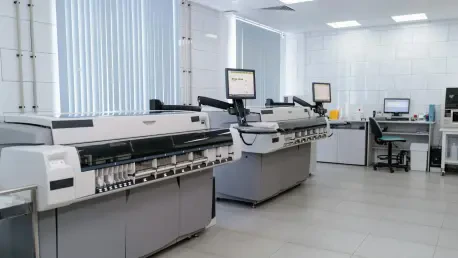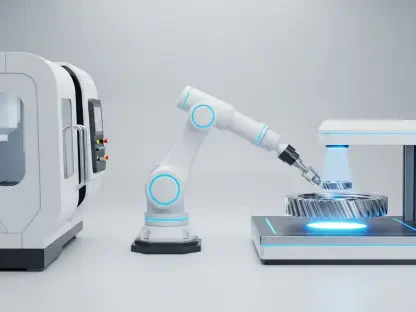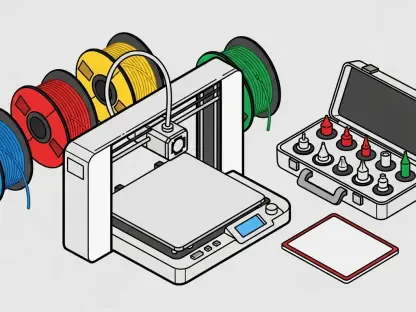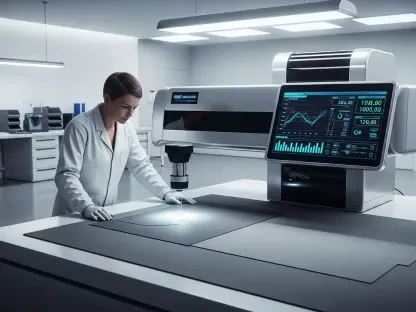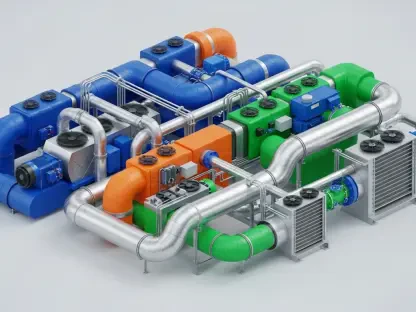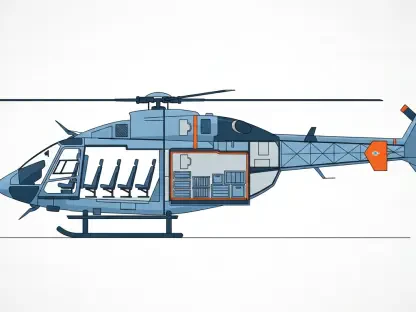Setting the Stage for a Manufacturing Revolution
In an era where manufacturing demands unprecedented agility, the commercial vehicle sector in India faces a staggering challenge: balancing traditional operational models with the urgent need for innovation, while striving to keep pace with global standards. Imagine a production line where design flaws are caught in real time, customer feedback instantly shapes product evolution, and downtime is virtually eliminated through predictive insights. This is no longer a distant vision but a tangible reality driven by digital continuity, a transformative approach reshaping how manufacturers operate. This review dives deep into the essence of digital continuity, exploring its mechanisms, impact, and potential to redefine efficiency, resilience, and sustainability in manufacturing.
The significance of this technology cannot be overstated, especially in an industry as critical as commercial vehicles, where delays or inefficiencies can ripple through supply chains and economies. Digital continuity offers a seamless integration of data across design, production, and usage phases, creating a dynamic ecosystem that responds to challenges with speed and precision. As global disruptions and market volatility continue to test manufacturers, understanding this innovation becomes essential for staying competitive in a rapidly evolving landscape.
Understanding the Concept of Digital Continuity
Digital continuity represents a paradigm shift in manufacturing by creating an integrated framework that connects every stage of a product’s lifecycle. At its core, it ensures that data flows seamlessly between design, production, and end-user feedback, forming a real-time loop that drives constant improvement. This approach emerged as a response to the pressing need for adaptability in industries like commercial vehicles, where traditional methods often struggle to keep pace with modern demands for customization and speed.
The relevance of digital continuity extends beyond operational efficiency to become a cornerstone of competitiveness. In a sector where balancing heavy-duty performance with environmental goals is paramount, this technology enables manufacturers to innovate without sacrificing reliability. It positions companies to anticipate market shifts and customer needs, ensuring they remain agile in an increasingly complex technological landscape.
Particularly in India, where the commercial vehicle industry supports vast logistics networks, digital continuity offers a pathway to harmonize legacy systems with cutting-edge solutions. By bridging these worlds, it fosters an environment where innovation is not just an option but a continuous process embedded in daily operations. This sets the stage for a deeper exploration of its core mechanisms and their transformative potential.
Core Components Driving Digital Continuity
Closed-Loop Systems for Real-Time Integration
A fundamental pillar of digital continuity is the closed-loop system, which ensures that data from design, manufacturing, and usage cycles back into the process for immediate refinement. This integration minimizes discrepancies between intended designs and actual outcomes, allowing manufacturers to detect and address issues as they arise. The result is a significant reduction in errors, which translates to faster time-to-market and enhanced product quality.
Beyond error reduction, closed-loop systems empower continuous improvement by creating a feedback-rich environment. For instance, insights from vehicle performance in real-world conditions can directly inform design tweaks, ensuring products evolve with user needs. This capability is especially critical in high-stakes industries where precision and reliability are non-negotiable, offering a competitive edge through iterative perfection.
The performance benefits of such systems are evident in their ability to streamline workflows across departments. By breaking down silos between engineering and production teams, manufacturers achieve a level of synchronization that accelerates innovation cycles. This synergy not only boosts efficiency but also builds resilience against unexpected challenges, making closed-loop integration indispensable.
Telematics and Data-Driven Insights
Another critical component is telematics, which harnesses vast data streams to optimize manufacturing and operational outcomes. Tools like Ashok Leyland’s M-PASS suite exemplify this by capturing thousands of data points per vehicle, enabling predictive maintenance and efficient fleet management. Such systems provide actionable insights that prevent breakdowns before they occur, ensuring uptime and reliability.
From a technical standpoint, telematics integrates sensors and connectivity to monitor vehicle health and usage patterns in real time. This data not only enhances customer satisfaction by minimizing disruptions but also feeds back into product development, allowing manufacturers to refine designs based on actual performance. The depth of these insights transforms raw information into a strategic asset for decision-making.
Real-world applications of telematics demonstrate its value in driving operational excellence. By analyzing usage trends, companies can tailor maintenance schedules to specific needs, reducing costs and extending asset lifespans. This data-driven approach underscores how digital continuity turns information into a powerful tool for both manufacturers and their clients, reinforcing its role in modern industry.
Recent Innovations Shaping the Field
The landscape of digital continuity is evolving rapidly, with innovations like model-based engineering gaining traction as a method to simulate and optimize designs before production. This approach reduces physical prototyping costs and accelerates development timelines, allowing manufacturers to test countless scenarios virtually. Such advancements are pivotal in managing the volatility inherent in today’s manufacturing environment.
Another notable trend is the widespread adoption of digital tools to enhance resilience against global disruptions. As supply chains face unpredictable challenges, these solutions provide the flexibility to pivot quickly, whether through rerouting resources or adjusting production schedules. This shift reflects a broader industry move toward proactive rather than reactive strategies, ensuring stability in uncertain times.
Behavioral changes within the sector also highlight the growing reliance on digitalization. Companies are increasingly investing in platforms that unify their operations, recognizing that staying ahead requires a commitment to technology as a core driver of innovation. From 2025 onward, this trend is expected to intensify, with digital continuity becoming a benchmark for operational success over the next few years.
Real-World Applications in the Commercial Vehicle Sector
In practical terms, digital continuity is making a profound impact on India’s commercial vehicle industry, where customization and efficiency are paramount. Ashok Leyland’s Avtar platform stands out as a prime example, enabling hundreds of thousands of unique vehicle configurations to meet diverse customer demands. This level of flexibility ensures that products align precisely with specific use cases, from urban transport to rural logistics.
Collaboration with technology providers like Dassault Systèmes further amplifies these benefits by enhancing systemic efficiency. Their solutions integrate data across the value chain, ensuring that every phase—from concept to delivery—operates in harmony. This holistic approach reduces bottlenecks and maximizes output, demonstrating how digital continuity translates into measurable gains on the shop floor.
Unique applications also emerge in the form of uptime optimization, where data from vehicle usage informs maintenance and design strategies. By leveraging real-time insights, manufacturers can minimize downtime and improve fuel efficiency, directly benefiting fleet operators. These tangible outcomes illustrate the technology’s capacity to address real challenges, solidifying its relevance in a competitive market.
Challenges and Limitations to Adoption
Despite its promise, digital continuity faces significant hurdles that slow its widespread implementation in manufacturing. Technical complexities, such as integrating disparate systems across legacy and modern platforms, pose a major barrier, often requiring substantial time and expertise to overcome. These integration challenges can delay the realization of benefits, testing the patience of stakeholders.
Regulatory concerns, particularly around data privacy and security, add another layer of difficulty. As digital continuity relies on vast data exchanges, ensuring compliance with stringent laws while maintaining operational flow is a delicate balance. Manufacturers must navigate these constraints carefully to avoid legal or reputational risks, which can deter investment in such technologies.
Market barriers, including high upfront costs, also limit adoption, especially for smaller players in the industry. While solutions are becoming more scalable through industry collaborations and technological advancements, the initial financial burden remains a sticking point. Addressing these obstacles will require concerted efforts to make digital continuity accessible and viable for a broader range of manufacturers.
Future Outlook for Transformation
Looking ahead, digital continuity holds immense potential to further revolutionize manufacturing through emerging integrations with artificial intelligence and advanced analytics. These technologies promise to enhance predictive capabilities, enabling even more precise responses to operational challenges. Such breakthroughs could redefine efficiency standards in the coming years.
The long-term impact of this innovation lies in its ability to support sustainable and adaptable manufacturing ecosystems. By aligning with multi-fuel strategies and decarbonization goals, digital continuity can help the industry reduce its environmental footprint while maintaining performance. This dual focus on sustainability and functionality positions it as a key enabler of future-ready operations.
As adoption grows, the technology is likely to become a linchpin for navigating complex market dynamics. From 2025 to 2027, expect increased investment in scalable solutions that democratize access to these tools, ensuring that even smaller manufacturers can harness their benefits. This trajectory suggests a future where digital continuity is not just an advantage but a fundamental requirement for success.
Reflecting on the Journey and Path Forward
Looking back, the exploration of digital continuity revealed a technology that has already begun to transform manufacturing with remarkable strides in efficiency and resilience. Its ability to integrate data across lifecycles has proven instrumental in reducing errors and accelerating innovation, particularly in India’s commercial vehicle sector. The real-world impacts, from customized configurations to uptime optimization, have underscored its practical value.
Moving forward, the focus should shift to overcoming adoption barriers through strategic partnerships and cost-effective solutions. Industry leaders must prioritize developing accessible platforms that cater to diverse manufacturing scales, ensuring inclusivity in this digital evolution. Investing in training and regulatory frameworks will also be crucial to address integration and privacy challenges effectively.
Ultimately, the next steps involve fostering a collaborative ecosystem where technology providers, manufacturers, and policymakers align toward shared goals. By incentivizing innovation and streamlining implementation, the manufacturing sector can fully unlock digital continuity’s potential. This proactive approach will pave the way for a more resilient and sustainable industry, ready to tackle tomorrow’s challenges with confidence.
